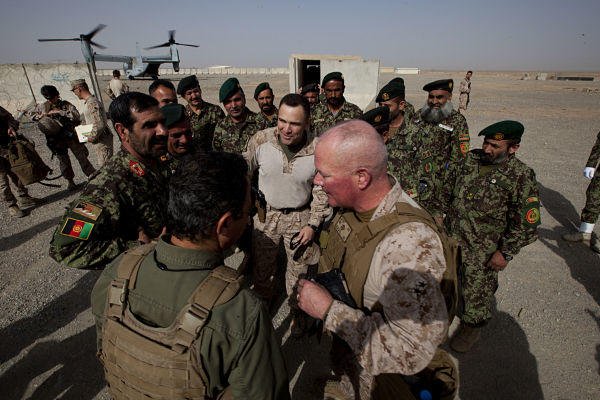The commander of U.S. and coalition troops in southwest Afghanistan said Afghan security forces are taking the lead in fighting insurgents and vowing to keep control of the region.
Afghan police and army personnel in recent days have repelled an estimated 150 Taliban fighters from the Sangin district while fending off attacks in other areas of Helmand province such as Musa Qala and Khanishin, according to Marine Corps Maj. Gen. Walter Miller.
"They've done this fight pretty much by themselves," he said via satellite during a May 29 press conference at the Pentagon. An Afghan general only requested help from coalition aircraft for personnel and logistical support, he said.
More than a decade after the start of the U.S.-led war in Afghanistan, American and NATO troops are primarily advising and assisting Afghan security forces in preparation of ending their combat mission next year.
There are some 63,000 U.S. troops in Afghanistan, according to Defense Department figures from last month. That's in addition to almost 40,000 troops from countries such as the United Kingdom, Italy and Germany in the country as part of NATO's International Security Assistance Force.
President Barack Obama in his State of the Union address earlier this year said the number of American troops in Afghanistan will be reduced by half by February 2014. The U.S. plans to withdrawal all combat forces from the country by the end of next year, leaving a residual force of to help Afghan security forces combat insurgents.
The Pentagon's proposed budget of $79.4 billion for the war next year would help fund an average of 38,400 troops in Afghanistan, according to budget documents.
Some of the heaviest fighting of the war has occurred in southwest Afghanistan. Five of the 10 provinces in the country with the highest levels of attacks are located in NATO’s Regional Command - Southwest, commanded by Maj. Gen. Miller. More than 20,000 Marines were sent into Helmand province in 2010 to drive out Taliban fighters. As Afghan forces took the place of withdrawing coalition troops, some insurgents have drifted back.
"If we think the Taliban will be completely destroyed, that's not feasible," Miller said. "They'll continue to show up. The key is that we get the Afghan National Security Forces to the level to where they can maintain security."
Miller, who commands the 2nd Marine Expeditionary Force, downplayed reports that as many as 1,000 Taliban fighters participated in the recent battle in Sangin. "The numbers were nowhere near 1,000," he said. "I'd say closer to 150 and the Afghans handled it."
Miller said some of the fighters were foreign, though he declined to specify which countries they came from. He also sought to minimize the significance of the battle. "I wouldn't describe it as pivotal at all yet," he said. "The fighting season is still up in the air and up for grabs."
While he has seen members of the Afghan military piloting planes and Russian-made Mi-17 helicopters, Miller said they'll continue to rely on U.S. forces and international partners for medical evacuation and logistical support.
Miller said he hasn't yet seen any so-called insider attacks, in which Afghans affiliated with the Taliban infiltrate police or military units and open fire on their comrades or international forces. An attack this week reportedly killed seven police officers in the remote southern district of Arghistan, including a commander.
"It will always be a concern,” he said. “We’re always taking precautions."





























